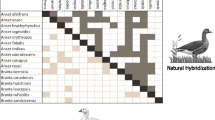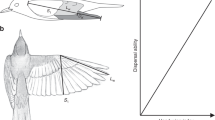Abstract
The number of hybrids recorded in the field may be biased because these data may simply reflect the detectability of a hybrid pairing. A questionnaire was constructed for assessing the detectability of natural avian hybrids. Ratings from 17 independent experienced observers were subjected to factor analysis and all observers loaded onto the same single factor. The reliability was extremely high (Cronbach’s alpha=0.96). Initially, I found a weak positive and significant correlation between the number of hybrids and their detectability index (r s=0.268; P=0.015; n=81). However, the respective correlations within three orders and one family containing enough hybrids for analysis revealed non-significant results. Significant differences existed among orders with respect to both detectability and hybrid frequency. At the family level, differences existed in detectability, but not in the number of hybrids recorded. Furthermore, I found no publication bias. These results suggest a general influence of detectability and on higher taxonomic levels, and that either detectability or the number of hybrids vary between orders possibly due to phylogenetic effects. Data about hybrids should be used in a cautious manner in analyses across a wide range of species, but seem unbiased when restricted to analyses within orders and families. As a rule of thumb, distinctness of hybrids seems to be a function of the plumage difference between the hybridising species.


Similar content being viewed by others
References
Adolfsson K, Cherrug S (1995) Bird identification. A reference guide. Anser [suppl] 37:1–379
Atteslander P (2000) Methoden der empirischen Sozialforschung. DeGruyter, Berlin
Böhning-Gaese K, Oberrath R (2001) Which factors influence the abundance and range size of Central European birds? Avian Sci 1:43–54
Gillham E, Gillham B (1996) Hybrid ducks. A contribution towards an inventory. Gillham, Lydd on Sea, Sussex, UK
Gillham E, Gillham B (2002) Hybrid ducks. The 5th contribution towards an inventory. Gillham, Lydd on Sea, Sussex, UK
Götmark F, Hohlfält A (1995) Bright male plumage and predation risk in passerine birds: are males easier to detect than females? Oikos 74:475–484
Grant PR, Grant RB (1992) Hybridization of bird species. Science 256:193–197
Hasselquist D, Sherman PW (2001) Social mating systems and extrapair fertilizations in passerine birds. Behav Ecol 12:457–466
Harvey PH, Pagel MD (1991) The comparative method in evolutionary biology. Oxford University Press, Oxford
Helbig AJ, Salomon M, Bensch S, Seibold I (2001) Male-biased gene flow across an avian hybrid zone: evidence from mitochondrial and microsatellite DNA. J Evol Biol 14:277–287
Johnson SG (1991) Effects of predation, parasites, and phylogeny on the evolution of bright coloration in North American male passerines. Evol Ecol 5:52–62
Møller AP (1997) Immune defence, extra-pair paternity, and sexual selection in birds. Proc R Soc Lond B 264:561–566
Randler C (1999) Zum Auftreten von Hybriden zwischen Tafel- und Reiherente Aythya ferina x A. fuligula in Deutschland, Österreich und der Schweiz. Vogelwelt 120:211–220
Randler C (2000) Wasservogelhybriden (Anseriformes) im westlichen Mitteleuropa—Verbreitung, Auftreten und Ursachen. Ökol Vögel 22:1–106
Randler C (2002) Avian hybridization, mixed pairing and female choice. Anim Behav 63:103–119
Sibley CG, Ahlquist, JE (1990) Phylogeny and classification of birds. A study in molecular evolution. Yale University Press, New Haven, Conn.
Tubaro PL, Lijtmaer D (2002) Hybridization patterns and the evolution of reproductive isolation in ducks. Biol J Linn Soc 77: 193–200
Underhill LG, Kalejta-Summers B (1995) Blood parasites in bright birds: testing the Hamilton-Zuk-hypothesis in sub-saharan Africa with improved statistical method. Ostrich 66:10–14
Acknowledgements
I wish to express my gratitude especially to Armin Baur for scanning photos and preparing parts of the questionnaire, and to Nils Anthes, Dr. Jürgen Blessing, Jan-Peter Daniels, Dr. Jochen Dierschke, Christian Dietzen, Hans-Georg Folz, Martin Gottschling, Dr. Nikolas Haass, Peter Knaus, Thorsten Krüger, Jörg Langenberg, Ulrich Mahler, Adrian Raidt, Frank Rheindt, Volker Schmidt, Christian Wegst and Ingo Weiß for rating the hybrid types. Dr. Nikolas Haass further provided helpful comments on an earlier draft of the manuscript. Two anonymous reviewers also gave helpful comments that improved the manuscript. Compiling data from original literature would never have been possible without the help of Dr. Jochen Hölzinger and his permission for visiting and using his library.
Author information
Authors and Affiliations
Corresponding author
Additional information
Communicated by F. Bairlein
Rights and permissions
About this article
Cite this article
Randler, C. Frequency of bird hybrids: does detectability make all the difference?. J Ornithol 145, 123–128 (2004). https://doi.org/10.1007/s10336-004-0022-0
Received:
Revised:
Accepted:
Published:
Issue Date:
DOI: https://doi.org/10.1007/s10336-004-0022-0




